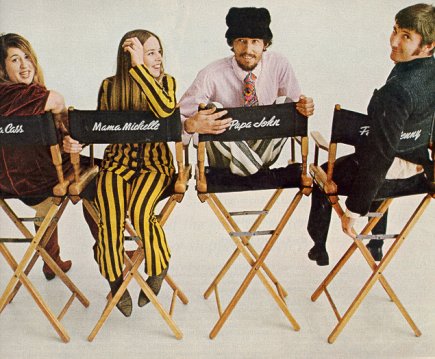| B i o g r a p h y |
 Inductees: Denny Doherty (vocals; born 11/29/41, died 1/19/07), Cass Elliot (vocals; born 9/19/41, died 7/29/74), John Phillips (vocals, guitar; born 8/30/35, died 3/19/01), Michelle Phillips (vocals; born 4/6/44).
Inductees: Denny Doherty (vocals; born 11/29/41, died 1/19/07), Cass Elliot (vocals; born 9/19/41, died 7/29/74), John Phillips (vocals, guitar; born 8/30/35, died 3/19/01), Michelle Phillips (vocals; born 4/6/44).
The Mamas and the Papas were
a major part of the Southern California pop scene of the mid to late
Sixties. Along with the Byrds, the Beach Boys, the Turtles and the
Association, they bombarded the Top Forty with superbly produced
folk-pop songs delivered with lush harmonies. What made the Mamas and
the Papas stand out was the mix of male (John Phillips, Denny Doherty)
and female (Cass Elliot, Michelle Phillips) voices. Combined with sharp
songwriting and arrangements from Phillips and musical contributions
from some of Los Angeles’ finest session musicians-especially
drummer Hal Blaine, bassist Joe Osborne and keyboardist Larry
Knechtel-the Mamas and the Papas cut some of the most unforgettable
songs of the Sixties. “California Dreamin’,” in
particular, endures as an anthem of those heady times.
The group formed out of the “New Folk” movement of the
late Fifties and early Sixties. John Phillips had been a member of the
Journeymen, a folk trio that also included Dick Weissmann and Scott
McKenzie. (McKenzie would go on record a song of Phillips’,
“San Francisco [Be Sure to Wear Flowers in Your Hair],”
that became a hit during the summer of 1967.) In a similar vein, Cass
Elliot had been in the Big Three, while Denny Doherty belonged to the
Halifax Three. Both Elliot and Doherty came together in the Mugwumps,
which also included John Sebastian and Zal Yanovsky, later of the
Lovin’ Spoonful. Michelle Phillips was an aspiring model (born
Holly Michelle Gilliam) and the wife of John Phillips.
John, Michelle and Denny performed in the New Journeymen, a
temporary group put together to fulfill contractual obligations after
the original trio’s breakup. In 1965, the three of them then
headed to St. Thomas, in the Virgin Islands, to write and rehearse.
They were joined by the alto-voiced Cass Elliot. The foursome relocated
to Los Angeles, where they signed to Lou Adler’s Dunhill label.
After briefly calling themselves the Magic Circle, they took the name
the Mamas and the Papas. If You Can Believe Your Eyes and Ears, their
first album, stands as a peak moment in the West Coast vocal-group
sound. It contains “California Dreamin’,” which
helped trigger the westward migration of rootless young people during
the hippie era. “I can’t tell you how many people have told
me over the years that the reason they were in California was because
they heard the song ‘California Dreamin’,” Michelle
Phillips recalled. “It changed their lives.” The Mamas and
the Papas’ vocal blend, with its intricate harmonies and
interweaving, prompted Life magazine to proclaim them “the most
inventive pop musical group and first really new vocal sound since the
Beatles.”
The Mamas and the Papas typified the new breed of groups that
followed in the wake of the Beatles as America formulated its own
response to the British Invasion. They dressed in colorful hippie garb
and projected diverse looks and personalities. Their group identity, in
fact, stemmed from their individuality and their rich blending of
voices. A string of hit singles followed “California
Dreamin’,” many of them-including “Monday
Monday,” “I Saw Her Again” and “Creque
Alley"-written or cowritten and arranged by John Phillips, who also
contributed acoustic guitar. In addition, the group astutely picked
material from the golden age of vocal groups, such as “Dedicated
to the One I Love” (originally cut by the Shirelles) and
“Spanish Harlem” (by the Drifters). They even made an
unlikely late-Sixties hit of “Dream a Little Dream of Me,”
which dated back to the 1930s and was recorded by Frankie Laine, Ella
Fitzgerald, Doris Day and others.
The members of the Mamas and the Papas reigned among the hip
vanguard of the L.A. scene during the late Sixties. John Phillips
served as one of the principal organizers of the Monterey International
Pop Festival, and the group performed at the historic event (though not
very well, by their own admission). Phillips, who organized the
festival with producer-impresario Lou Adler, reflected years later on
what Monterey meant: “It gave the world an opportunity to hear
just what new music was happening on this planet and how much it was
changing.” It also served to introduce hip young rock fans to the
Jimi Hendrix, Otis Redding, Janis Joplin, and the Who.
The Mamas and the Papas broke up in 1968 due to infighting after
recording The Papas & the Mamas. They reunited briefly in 1971 to
cut People Like Us in order to meet a contractual obligation and
thereupon disbanded to pursue solo careers. Mama Cass was the most
successful of them, though she was plagued by health problems and died
of a heart attack in 1974. John and Michelle were divorced in 1970, and
Michelle went on to a successful acting career. John increasingly grew
involved in the drug scene, a fall from grace candidly documented in
his excellent autobiography, Papa John. After a well-publicized drug
bust, Phillips cleaned up and re-formed the Mamas and the Papas in
1982. The group included founding member Denny Doherty and two new
“Mamas”: MacKenzie Phillips (daughter of John) and Elaine
“Spanky” McFarlane, a longtime friend who’d sung with
Spanky and Our Gang back in the Sixties.